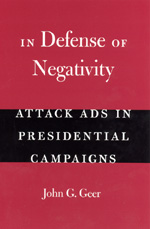John Geer’s
Attack Ad
Hall of Fame
John G. Geer, author of In Defense of Negativity: Attack Ads in Presidential Campaigns, doesn’t follow the conventional wisdom about negative television ads. He argues that negative ads are positive—negative ads focus on important political issues and give voters critical information about differences between candidates. Attack ads do not degrade, but rather enrich the democratic process.
The Best Known Attack Ad
 Johnson’s Daisy spot from 1964. This ad was only aired once but is still talked about today. It used the innocence of a little girl to raise the horrors of nuclear war. The creator of the ad, Tony Schwartz, argues that the ad is not at all negative, that it was a positive issue ad, discussing the most pressing matter of the day—nuclear war. He does have a point: Goldwater’s name is never mentioned in the ad. But even so, it was Goldwater’s past statements about the tactical use of nuclear weapons that made the ad come to life.
Johnson’s Daisy spot from 1964. This ad was only aired once but is still talked about today. It used the innocence of a little girl to raise the horrors of nuclear war. The creator of the ad, Tony Schwartz, argues that the ad is not at all negative, that it was a positive issue ad, discussing the most pressing matter of the day—nuclear war. He does have a point: Goldwater’s name is never mentioned in the ad. But even so, it was Goldwater’s past statements about the tactical use of nuclear weapons that made the ad come to life.
The Earliest Known Attack Ad
 Attack ads are as old as television; both major candidates aired them in 1952. The theme of a 1952 Democratic attack ad was that the Republicans engaged in double speak—that they would say one thing to one group and another to another group. This is an enduring theme in campaigns: that the opposition cannot be trusted to do what they say.
Attack ads are as old as television; both major candidates aired them in 1952. The theme of a 1952 Democratic attack ad was that the Republicans engaged in double speak—that they would say one thing to one group and another to another group. This is an enduring theme in campaigns: that the opposition cannot be trusted to do what they say.
Most Effective Attack Ad
 This is a tough one, since we do not have lots of data about effectiveness. But given that the Daisy spot was aired only once and is still talked about, it might be a good choice. Another contender would be the infamous Willie Horton ad that used the issue of crime as a way to play a race card against Michael Dukakis in 1988. It is doubtful this ad recast the election, since Vice President Bush was in the lead in the polls at the time. Even so, it remains a powerful reminder about how race can be manipulated in American elections.
This is a tough one, since we do not have lots of data about effectiveness. But given that the Daisy spot was aired only once and is still talked about, it might be a good choice. Another contender would be the infamous Willie Horton ad that used the issue of crime as a way to play a race card against Michael Dukakis in 1988. It is doubtful this ad recast the election, since Vice President Bush was in the lead in the polls at the time. Even so, it remains a powerful reminder about how race can be manipulated in American elections.
Least Effective Attack Ad
 Mondale 1984. He ran a negative ad trying to suggest that if Reagan was re-elected we would need to start digging bomb shelters—that Reagan was leading us down a path to nuclear war. It was a theme that had much in common with the famed Daisy spot. But it did not play well. Reagan was popular and had shown no signs that he would use nuclear weapons. He was not willing to bargain with the Soviets, but many people approved of that position. Former Vice President Mondale lost the election in one of the most lopsided outcomes of all time.
Mondale 1984. He ran a negative ad trying to suggest that if Reagan was re-elected we would need to start digging bomb shelters—that Reagan was leading us down a path to nuclear war. It was a theme that had much in common with the famed Daisy spot. But it did not play well. Reagan was popular and had shown no signs that he would use nuclear weapons. He was not willing to bargain with the Soviets, but many people approved of that position. Former Vice President Mondale lost the election in one of the most lopsided outcomes of all time.
Boomerang Ad: An Attack that Backfired
 Carter aired ads that tried to paint Reagan as someone who was not prepared to be president. The ads questioned whether Reagan had the judgment and insight to lead the nation. Yet Reagan showed during the course of the 1980 campaign that he was prepared to lead, undermining this claim. Perhaps the best example of this came during the presidential debate of 1980 where Reagan came across as informed and sober in his judgment. For an attack ad to work, it must raise a credible issue. Reagan was ready to be president and certainly his eight years in office proved that point.
Carter aired ads that tried to paint Reagan as someone who was not prepared to be president. The ads questioned whether Reagan had the judgment and insight to lead the nation. Yet Reagan showed during the course of the 1980 campaign that he was prepared to lead, undermining this claim. Perhaps the best example of this came during the presidential debate of 1980 where Reagan came across as informed and sober in his judgment. For an attack ad to work, it must raise a credible issue. Reagan was ready to be president and certainly his eight years in office proved that point.
The Most Informative Attack Ad
 Negative ads tends to be more informative than positive ads. So there are lots of choices. The wind surfer ad from 2004 used against Kerry is a good example, as is the Social Security spot used against Goldwater in 1964 that documented his plan to change this highly popular program. In the 1964 spot, the ad offers seven specific pieces of evidence documenting Goldwater’s support for altering social security. It was a devastating attack. Forty years later, the Bush campaign ran an ad that showed in thirty seconds the opposite positions John Kerry took on the same issue. It illustrated with some precision Kerry’s tendency to flip flop on the key issues of the day.
Negative ads tends to be more informative than positive ads. So there are lots of choices. The wind surfer ad from 2004 used against Kerry is a good example, as is the Social Security spot used against Goldwater in 1964 that documented his plan to change this highly popular program. In the 1964 spot, the ad offers seven specific pieces of evidence documenting Goldwater’s support for altering social security. It was a devastating attack. Forty years later, the Bush campaign ran an ad that showed in thirty seconds the opposite positions John Kerry took on the same issue. It illustrated with some precision Kerry’s tendency to flip flop on the key issues of the day.
The Least Informative Attack Ad
 The bear in the woods ad from 1984. The Reagan campaign aired the ad. “There is a bear in the woods. For some people, the bear is easy to see. Others don’t see it at all.” The script goes on to say that we need to be as strong as the bear and that we should not risk being unprepared. Who is the bear? The Soviet Union? Probably, but since it’s not clear, some argue that the spot is not negative. It’s an interesting ad and one that probably was run because of Reagan’s huge lead over Mondale. It’s subtle meaning just makes it not very informative.
The bear in the woods ad from 1984. The Reagan campaign aired the ad. “There is a bear in the woods. For some people, the bear is easy to see. Others don’t see it at all.” The script goes on to say that we need to be as strong as the bear and that we should not risk being unprepared. Who is the bear? The Soviet Union? Probably, but since it’s not clear, some argue that the spot is not negative. It’s an interesting ad and one that probably was run because of Reagan’s huge lead over Mondale. It’s subtle meaning just makes it not very informative.
John Geer’s Favorite Attack Ad
 My personal favorite is the Dukakis tank ride from 1988. It was a brilliant ad by the GOP, using Dukakis’s own footage against him. The ad laid out the fact that Bush was more supportive of military spending and weapons programs than Dukakis, using video in which Dukakis looked like anything but a leader. Part of the reason I like this spot is that it was the first to generate a counterspot from the opposition. That is, Dukakis aired an attack ad criticizing Bush for airing this ad and “distorting” his record. If you listen closely to this ad you will hear the sound of grinding gears, suggesting that Dukakis cannot even run the tank smoothly. That sound was added to the footage; tanks do not have gears that grind. The gear sounds were of an 18-wheeler.
My personal favorite is the Dukakis tank ride from 1988. It was a brilliant ad by the GOP, using Dukakis’s own footage against him. The ad laid out the fact that Bush was more supportive of military spending and weapons programs than Dukakis, using video in which Dukakis looked like anything but a leader. Part of the reason I like this spot is that it was the first to generate a counterspot from the opposition. That is, Dukakis aired an attack ad criticizing Bush for airing this ad and “distorting” his record. If you listen closely to this ad you will hear the sound of grinding gears, suggesting that Dukakis cannot even run the tank smoothly. That sound was added to the footage; tanks do not have gears that grind. The gear sounds were of an 18-wheeler.
More
All of the attack ad links go to the extensive collection of television campaign ads available from the Museum of the Moving Image.
Comments can be made on our blog.
Copyright notice: ©2008 by John G. Geer. All rights reserved. This text may be used and shared in accordance with the fair-use provisions of U.S. copyright law, and it may be archived and redistributed in electronic form, provided that this entire notice, including copyright information, is carried and provided that the University of Chicago Press is notified and no fee is charged for access. Archiving, redistribution, or republication of this text on other terms, in any medium, requires the consent of the author and the University of Chicago Press.
John G. Geer
In Defense of Negativity: Attack Ads in Presidential Campaigns
©2006, 218 pages, 32 line drawings, 12 tables
Cloth $47.50 ISBN: 9780226284989
Paper $21.00 ISBN: 9780226284996
For information on purchasing the book—from bookstores or here online—please go to the webpage for In Defense of Negativity.
See also:
- Our catalog of books in politics and poltical science
- Other books in the Studies in Communication, Media, and Public Opinion series
- Other excerpts and online essays from University of Chicago Press titles
- Sign up for e-mail notification of new books in this and other subjects
- Read the Chicago Blog
